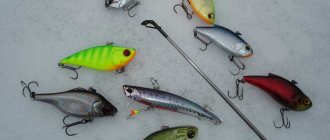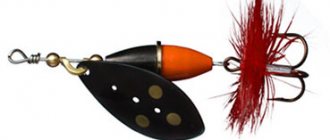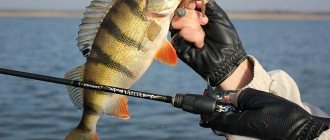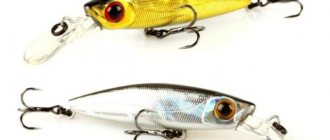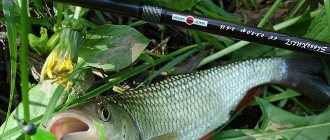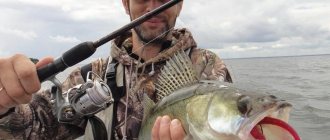| № | Name | Rating | Nomination |
| The best vibes and ratlins for pike perch – cost up to 500 rubles | |||
| 1 | Pontoon21 Bet-A Vib | 5.00 | The most popular choice of Russian fishermen |
| 2 | Izumi Eimann Vib | 4.83 | Best price |
| 3 | ITUMO Gamauji | 4.71 | The heaviest ratlin in the category |
| 4 | Yoshi Onyx Primula Vibe | 4.68 | The most versatile ratlin |
| 5 | KYODA SMART (SOFT) VIB | 4.32 | An attractive “game” for well-fed fish |
| The best vibes and ratlins for pike perch - cost up to 1000 rubles | |||
| 1 | Rapala Rattlin | 4.96 | The most popular vibe in Russia |
| 2 | ECOPRO VIB Nemo Slim | 4.75 | The best combination of price and quality |
| 3 | Lucky John Soft Vib | 4.56 | The most popular new product |
| 4 | Duel Hardcore Fintail Vibe | 4.37 | Improved animation efficiency |
| 5 | Usami Vertigo | 4.29 | The most accessible vibe in the category |
| The best vibes and ratlins for pike perch – cost from 1000 rubles | |||
| 1 | Madness Shiriten Bass Vibe | 4.93 | Better bite detection |
| 2 | Bassday Range Vib | 4.81 | The most reliable choice for trophy fishing |
| 3 | Madness Shiriten Baguette | 4.76 | The choice of experienced paddlers |
| 4 | DUO Bay Ruf | 4.51 | Best value in category |
| 5 | Smith Bay Blue | 4.12 | Reliable operation of equipment on water bodies with current |
Vibrating bladeless wobblers will help ensure catchable fishing for pike perch in winter from ice. Sinking vibrations are used primarily for winter fishing. In summer, the bait is no less popular among those who like to fish from a boat. The Estonian Rapala Rattlin was the first equipment of this type to appear in our country, and was so loved by fishermen that wobblers of this type were often called ratlins.
Today there are a lot of vibrations from different companies on the fishing equipment market, but the most widely represented are Japanese vibrating wobblers, which provide a bright and attractive game for river predators. To determine the most catchy ratlins, we studied hundreds of opinions and reviews that were left online by anglers, including professional ones. We hope the information received will be useful and help you make the right choice. For convenience, all vibes have been divided into price categories.
Top 5. KYODA SMART (SOFT) VIB
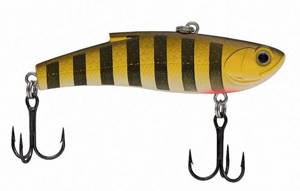
Rating (2020): 4.32
- Nomination
An attractive “game” for well-fed fish Vib KYODA SMART (SOFT) VIB, thanks to the elasticity of the body, creates a powerful irritating factor for river predators, not leaving even sluggish fish indifferent.
- Characteristics
- Average price: 340 rub.
- Country: China
- Length, mm: 70
- Wobbler weight, g: 16-21
For many anglers, a trip to a pond in winter is not complete without this catchy bait. KYODA SMART VIB belongs to the rattlin class and is designed for catching pike perch and other predatory fish. The popular winter vibration allows you to effectively fish for prey in deep places (pools, holes). Bright coloring (several options are available for sale) and characteristic game attract even sluggish and well-fed fish. The bait is made of soft material (SOFT), equipped with two tees - in the front and rear parts of the “fish”, which gives a reliable hook and reduces the likelihood of derailment to a minimum. The Japanese ratlin is most often used when fishing from ice, but can also be used in the summer for vertical fishing from a boat.
Top 4. Yoshi Onyx Primula Vibe
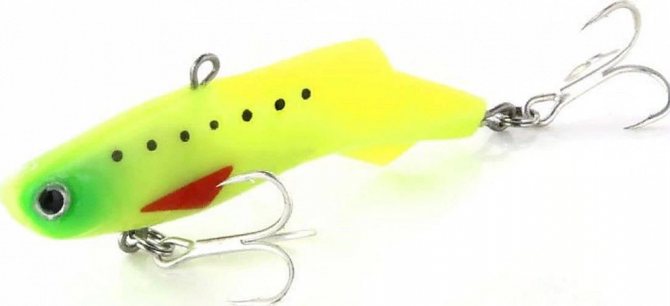
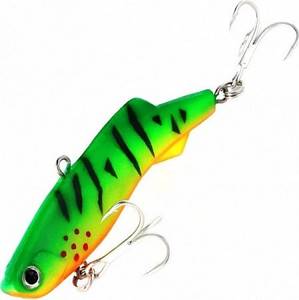
Rating (2020): 4.68
- Nomination
The most universal Ratlin Thanks to the peculiarities of its design, the Vibe is optimally suited for both winter ice fishing and summer spinning fishing for pike perch.
- Characteristics
- Average price: 320 rub.
- Country: China
- Length, mm: 53-80
- Wobbler weight, g: 8.5
A special feature of this catchy Japanese rattlin is its two-layer construction, consisting of a weighted core and a durable polymer coating. On the one hand, this provides expanded possibilities for animation when catching pike perch from the ice, on the other hand, it creates opportunities for long-distance casting during summer fishing. The vibration operates silently and looks natural both when installed vertically in winter and horizontally in summer. The game is provided by a ledge at the top of the “fish”. Two sharp, proprietary tees in the front and back of the popular Ratlin make it the best in terms of hooking reliability. The choice of colors allows you to find an effective option for winter or summer fishing.
Catching pike perch in winter from ice on ratlins
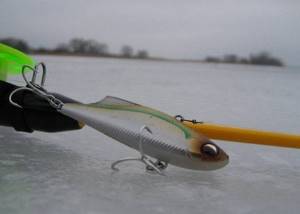
The wiring for each ratlin must be selected. There are no uniform recommendations here. Fishing with vibrations differs from fishing with balancers in that you need to act more restrained and carefully. Sharp jerks will scare away pike perch, while smooth rises and controlled drops will attract them. The overall picture looks like this:
- Find the bottom.
- Smoothly raise the vibration and release it. Depending on the model, you can accompany him during the descent or let him go freely.
- Make light twitches at the top and bottom points (as when carefully playing with a jig).
It’s better to watch a video about how to catch passive pike perch in winter using ratlina horizontal lures, or even better, learn this on a pond from experienced fishermen, simply repeating their movements. Over time, you will begin to feel the game and, depending on how this or that bait behaves underwater, you will adjust the height and speed of rise, control the descent and determine pause points.
Conclusion
Deep-sea vibes are used for vertical fishing from holes, including in pits, you just need to choose the right weight. For passive pike perch, it is better not to use bait with rattles. Ratlins for catching pike perch in winter ice fishing do not have to be expensive. Considering their high grip, this is good news.
Top 3. ITUMO Gamauji
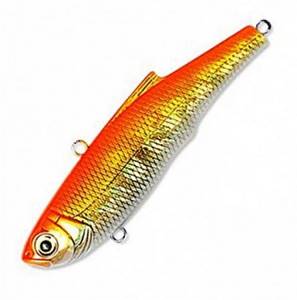

Rating (2020): 4.71
- Nomination
The heaviest ratlin in the category The ITUMO Gamauji range has vibrations weighing up to 35 g, which are ideal for catching trophy zander.
- Characteristics
- Average price: 422 rub.
- Country: South Korea
- Length, mm: 55-90
- Wobbler weight, g: 9-35
Among winter fishing enthusiasts, Korean catchy rattlins are popular, designed for pike perch and pike perch not only in winter, but also in summer. The well-catching vibration is not inferior to the leading Japanese analogues, but the price of the equipment is noticeably lower. The body shape of the “fish” is elongated, the fishing line mount is located on the back. This promotes better play that attracts predators. The silent ratlin is optimal for fishing from ice with vertical fishing, but in summer it is also effective when fishing in deep places from a boat in reservoirs with calm water. Color options can be selected to suit any conditions - from calm natural colors to bright acidic colors. Reliable hooking is ensured by two sharp tees in the front and tail parts of the body.
Choosing a place and time of fishing
For most of the winter, pike perch sticks to places with great depth, a hard bottom and a constant flow of fresh water. The most catchy places are such places as:
- deep channel holes;
- pools littered with snags;
- places under steep ravines with a sharp drop into depth and trees lying in the water.
Closer to spring, on the last ice, like most fish, pike perch comes closer to the shores - at this time it can be found in river bays and backwaters in areas with medium depth and a flat, hard bottom.
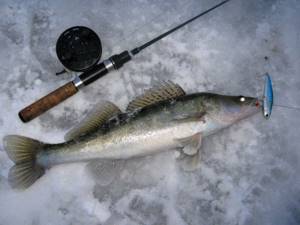
On the first and last ice, pike perch can be caught throughout the daylight hours; in the dead of winter, its bite is very unpredictable and the predator is more active from early morning until noon and in the evening until dusk.
Top 2. Izumi Eimann Vib


Rating (2020): 4.83
- Nomination
Best price The Japanese Ratlin Izumi Eimann Vib is the most affordable among budget vibs. Purchasing its closest competitor, the Chinese wobbler KYODA SMART (SOFT) VIB, will cost 20% more.
- Characteristics
- Average price: 263 rub.
- Country: Japan
- Length, mm: 70
- Wobbler weight, g: 15
In the arsenal of many fishermen who prefer winter fishing, there is this popular Japanese bait, which is good for pike perch and other predatory river fish. Inexpensive, but catchy, the sinking rattlin allows you to fish both from the ice and from the shore, in winter and summer - in the warm season, the vib's ability to cast long distances is used. But still, the ratlin reveals its best qualities when moving vertically during winter fishing. The ring for attaching the fishing line is located so that the front part has a downward slope, which reduces the likelihood of snagging on bottom objects. Internal cavities with steel balls create noise and vibration during wiring, additionally attracting predators. The color spectrum is dominated by calm, natural colors.
See also:
- 10 best balancers for zander
Top 1. Pontoon21 Bet-A Vib
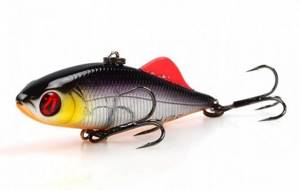
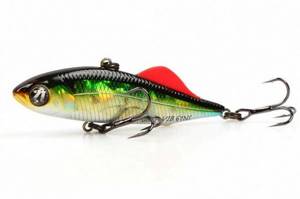
Rating (2020): 5.00
17 reviews from resources taken into account: Ozone
- Nomination
The most popular choice of Russian fishermen. The domestic manufacturer produces Pontoon21 Bet-A Vib, which, in terms of its characteristics, competes on equal terms with more expensive foreign-made products.
- Characteristics
- Average price: 470 rub.
- Country Russia
- Length, mm: 48-61
- Wobbler weight, g: 5.6-14.5
Many winter fishing enthusiasts characterize this vibration as the best among bladed rattlins for catching pike perch and other predators. Not everyone knows that ratlins and other gear under this brand are produced by a domestic manufacturer. The level of equipment is not inferior to the best and most popular Japanese baits for fishing for river predators. This gear is considered especially catchy when catching pike perch from ice. The average weight and size of the ratlin ensure the tackle is surprisingly fast due to its special fin-shaped blade. This expands the possibilities of animation when wiring. The tackle is sold without hooks - you can install any. The range of colors includes both calm and bright colors.
See also:
- 10 best lures for zander
to the beginning of the rating
Top 5. Usami Vertigo

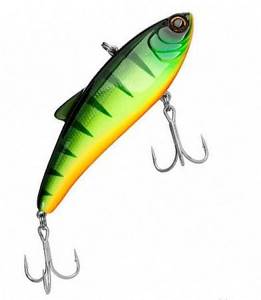
Rating (2020): 4.29
- Nomination
The most affordable vibe in the Ratlin category, Usami Vertigo, will cost its owner 10% less than the similar Japanese VIB Duel Hardcore Fintail Vibe.
- Characteristics
- Average price: 530 rub.
- Country: Japan
- Length, mm: 80
- Wobbler weight, g: 22.2
Many winter fishing enthusiasts use this popular fishing gear of Japanese origin to catch pike perch from the ice. The design is not quite common for this category - the rattlin has a narrow frontal part and widening from the back to the tail. This reduces the vibration frequency during wiring, but increases the amplitude of acoustic waves. It also creates a complex pattern of play in the vertical and horizontal planes, which additionally attracts fish. Ratlin shows better efficiency with vertical (uniform or stepped) fishing in winter (the best depth is up to 12 m), but allows you to catch by casting in summer. There is a smaller version for perch. The range of colors is dominated by bright shades.
Winter fishing for pike perch using rattlins
Many of the baits that work for pike perch during the summer can also be successfully used on ice. It is important that the bait works well on the vertical component during rise and free fall.
Features of catching pike perch in winter: feeding, retrieving
There are many animation options, we list the most universal ones:
- Option one. The bait sinks to the bottom with a characteristic vibration and an impact on the ground at the end - this will create a small amount of turbidity, often at this moment the bite occurs. Then a throw of 40-50 centimeters is made with the rod and the bait falls down on a free line. At the end there is a pause during which the bait continues to vibrate. And thus the rattlin rises 1-2 meters from there until it finds the horizon in which the pike perch is most active.
- Option two. The bait reaches the bottom and rises from there by 10-20 cm and is animated with small-amplitude movements. No sudden movements. This is often the most suitable option for pike perch.
- Option three. A combination of the previous two. Playing above the bottom of the reservoir, then the first version of the wiring, lowering all stages of the animation to the bottom and in a circle.
What works in winter: principles for selecting a vibe, the best working models
Pike perch almost always stands near the bottom, where visibility is low or zero. Therefore, in terms of colors, “chemical” colors and fluorescent colors are preferred.
The size of the rattlin is selected experimentally and the depth at the fishing site.
Silent models are used more often, but “summer” noisy models are also used with success if they have their own game on the fall/rise.
The following ratlins have proven themselves well for winter pike perch:
- Jackall NT60 (Silent). 60 mm, 12.7 grams. All-season rattlin. Works in free fall when fishing vertically. Price 800+ rubles
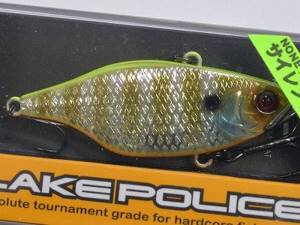
- DUO Bay Ruf SV, 80 mm, 15 grams. Quite a working model for winter underwater fishing. Progonist form, works on the vertical component. Price from 1000 rubles
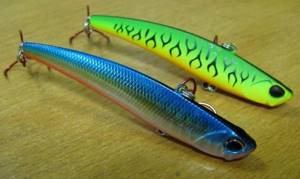
- Jackall TN Slim 8 . 80 mm, 12 grams. Equipped with tungsten ball rattles. But that doesn’t stop it from catching in winter. Price 1200+ rubles.
- Yo-zuri 3D Vibe. Working depths up to 5 meters. Price 800 rubles

- Yo-Zuri Hardcore VIB 70S. An analogue of Drum (see above summer rattlins for pike perch), only silent. Price in the area 800 rubles
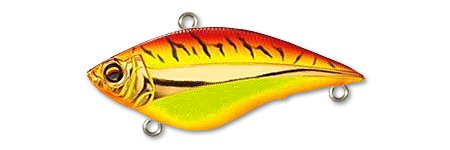
We do not recommend using Chinese baits in winter. They have virtually no play in the vertical plane, which makes them unsuitable for catching predators from the ice.
In winter, for passive fish it is worth experimenting with changing baits. Collect fish with noisier and larger rattlins, and catch fish with smaller and silent ones. For cautious fish this often gives good results.
Top 4. Duel Hardcore Fintail Vibe
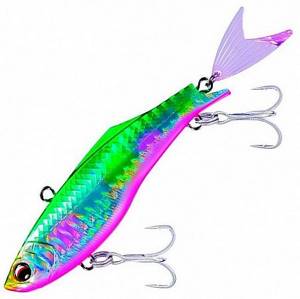
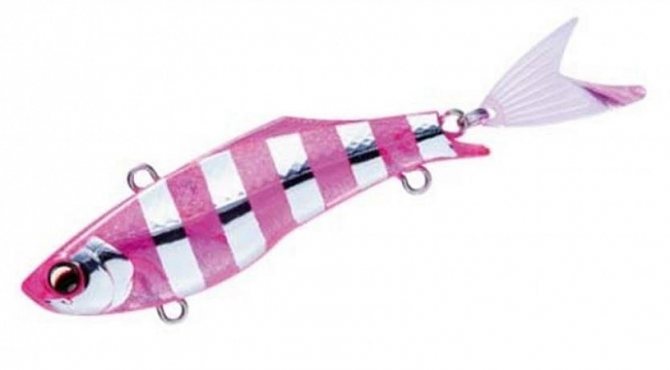
Rating (2020): 4.37
- Nomination
Enhanced Animation Efficiency Thanks to its movable fin, the Yo Zuri Duel Hardcore Fintail Vibe creates the most attractive game that can awaken the interest of even a jaded predator.
- Characteristics
- Average price: 580 rub.
- Country: Japan
- Length, mm: 40-70
- Wobbler weight, g: 4-18
Catchable winter tackle from the popular Japanese brand Yo Zuri has a good reputation among ice fishing enthusiasts. The developers of the vibration achieved maintaining the position of the rattlin's body without falling on its side. This was achieved by using multiple fins, and now the tackle has the best stability in its class. One blade is equipped with a movable mount, which creates a game that attracts the attention of pike perch and other predators. Another effect of vibration is the emission of additional noise. Another advantage of the gear is its ability to dive quickly. The combination of the developers’ decisions has become a good basis for effective fishing for pike perch, pike perch and large perch in winter.
Top 3. Lucky John Soft Vib
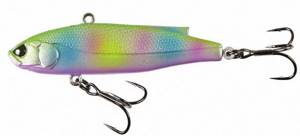
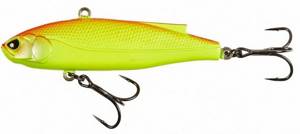
Rating (2020): 4.56
- Nomination
The most popular new product, Vib, quickly became popular in Russia, demonstrating excellent catchability from ice on various bodies of water.
- Characteristics
- Average price: 785 rub.
- Country: Estonia
- Length, mm: 40-80
- Wobbler weight, g: 6-22
Lucky John Soft Vib, a new product for the 2019-2020 winter season, quickly proved that it is one of the most catchy tackles for pike perch. Rattlin is made of a soft polymer that feels like rubber. The elaboration of the body vibe is at the level of the best Japanese designs - relief, drawing, coloring. The geometry turned out to be narrow and “straightforward”, which contributes to the special vibration of the ratlin. When pulled smoothly, the tackle realistically imitates a trembling fish. Also, this shape allows you to successfully use the bait in bodies of water with a current. There are no noise effects - the likelihood of scaring off wary prey is reduced. The effectiveness of catching pike perch and other predators from ice in winter quickly made the gear popular. It was successfully used this year during summer fishing.
Wiring technique
In principle, playing with bait needs to be taken seriously, and when fishing for pike perch in winter with ratlins, this is especially important. Any micro-movement among the wiring variations can determine whether the predator will take it or not. From the outside, everything is simple - the fisherman twitches the tackle above the hole. But if you look closely, you can see that this happens according to a certain pattern, and not chaotically. In general, winter pike perch loves monotony and a large number of absolutely identical (in the smallest details) repetitions. The technique of catching pike perch in winter with ratlins can only be learned through practice while fishing and at home in a bath of water (preliminarily, to study the action of the bait). We can only give here general trends and recommendations with which to start an experiment on a reservoir. Techniques for playing ratlin in winter for pike perch:
- For active fish, the vibration game is used to its fullest.
- Tossing a ratlin is less of a sharp jerk (like a balance beam), but a smooth, quick pull.
- After the toss - free fall. Some models require a line to accompany them when lowering. This whole moment needs to be worked out in a container of water.
- In general, smooth movements with long pauses and small amplitudes work for winter pike perch.
- Most ratlins turn on their side with a short jerk and immediately return to their normal position. In this case, a glare occurs, as in the behavior of a beaten fish. But with a high drop, the bait prowls, moves to the side, in a circle, etc. The general wiring tactic is alternating these methods, with a clear advantage of the first. Sharp jerks with active play should only be done occasionally. But a passive, low-amplitude game needs to be played monotonously for a long time.
- Sometimes the wobbler slows down at the end of the reset.
- Sometimes the pike perch takes on a pause, at other times - when the ratlin falls.
- For a very passive predator, what often works is not play, but sluggish movement with almost no tossing at all. Trembling, centimeter swaying. Occasionally - small pulls of 10-15 cm. In this case, you can attach pieces of sprat or strips of multi-colored rubber (tassels) to the hooks.
Top 2. ECOPRO VIB Nemo Slim


Rating (2020): 4.75
- Nomination
The best combination of price and quality The Russian ratlin ECOPRO VIB Nemo Slim is distinguished by a balanced price and high efficiency when ice fishing for trophy pike perch.
- Characteristics
- Average price: 538 rub.
- Country Russia
- Length, mm: 60-80
- Wobbler weight, g: 12-22
This catchy rattlin is a development of the company's line of winter vibes designed for catching pike perch. Unlike the popular Nemo 70S prototype, the new Ratlin is slightly longer and significantly heavier than its predecessor. As a result, the bait turned out to be more adapted for deep ice fishing in winter. It showed excellent performance when fishing in strong currents – it attracts trophy-sized predators well. Reliable hooking is facilitated by two sharp tees - the quality is at the level of the best Japanese hooks. The line mount is shifted forward, which also contributes to the variety of animation. The ability to glow in ultraviolet light increases the chances of successful fishing.
See also:
- 10 Best Brands of Boots for Ice Fishing
Top 1. Rapala Rattlin
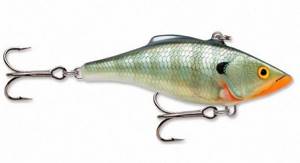
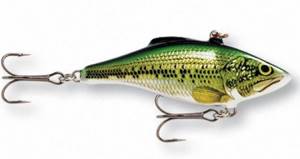
Rating (2020): 4.96
- Nomination
The most popular vibe in Russia The first vibe to appear on the Russian market and give a new name to vibrating lures. Ratlin has excellent catchability and is popular with anglers of varying levels of training.
- Characteristics
- Average price: 785 rub.
- Country: Finland
- Length, mm: 40-80
- Wobbler weight, g: 6-22
The popular Finnish manufacturer of rattlins and other types of baits is the first to offer domestic winter fishing enthusiasts a catchy vibe that is effective in catching pike perch and other river predators. The appearance of the ratlin is very realistic. Scales, eyes, gills - everything is carefully worked out. The quality of four-color printing is not inferior to the best Japanese samples. This made the relief detailing unnecessary. A noise capsule with metal balls creates acoustic waves that complement the active vibration of the body of the tackle. The head part has a concave shape and is, in fact, a blade that sets the trajectory of movement, characteristic of a wounded or weakened fish. It is recommended for fishing from ice in the winter, but many people successfully catch the predator in the summer from a boat.
See also:
- 15 best ice screws
to the beginning of the rating
What are rattlins?
Depending on the size, this type of bladeless wobbler works for catching pike perch of all sizes.
Important! When collecting gear, pay attention to the weight of the fish. If fishing will be done in deep water, be sure to use heavy weights. If there are no trophies in the river, rattlins are selected according to size.
Description of the bait and rattlin structure
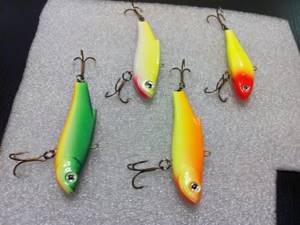
In appearance, they resemble a small fish, slightly flattened on the sides. The material used to make the models is high-quality plastic. The fish is made hollow. There is a rattle inside (a chamber with small balls placed in it), which makes a noise that attracts pike perch.
There is a ring on the back for attaching to the forest. It is customary to place it at a distance from the front of the body. This distance should not exceed a third of the length of the bait. There are 2 fastening rings at the bottom for securing the tees. They are located opposite the upper ring and in the tail section. When performing wiring, the rattlin produces small oscillatory movements in the water.
The bait was first manufactured by Papala Rattlin, which is where its name comes from. But it is more correct to call it a “bladeless crank.” Fine-frequency vibrations, which so attract pike perch, are a distinctive feature of this species. The inconvenience may be caused by the ability of rattlins to get caught on any obstacles.
Important! It is better to catch trophy pike perch with rattlins, the length of which is 70 mm. In this case, the best color scheme is the silver or transparent color of the fish. The purity of the water should be taken into account. In muddy water, bright, poisonous colors are more attractive to predators. Clean water requires the use of natural color bait.
Top 5. Smith Bay Blue
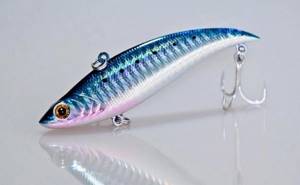
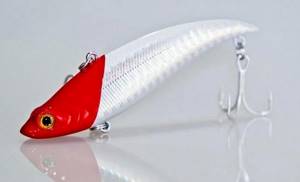
Rating (2020): 4.12
- Nomination
Confident operation of the rig in water bodies with a flow of the Smith Bay Blue VIB, designed for pike or pike perch, is distinguished by its large weight and sweeping vibrations, which confidently attract predators in water bodies with an average current speed.
- Characteristics
- Average price: 1523 rub.
- Country: Japan
- Length, mm: 90
- Wobbler weight, g: 21-28
Fishing enthusiasts enjoy and successfully use this weighted rattlin for winter ice fishing. The popular vibe is designed for vertical trolling in winter and summer (from a boat) for predatory fish, including pike perch. The shape and balance of the tackle encourages play with wide swings that attract the attention of potential prey. Two tees with the best anti-corrosion coating are attached to the tail and middle parts of the ratlin. This further enhances the effect of luring fish and makes the tackle one of the most catchy. The coloring is holographic, with a predominance of bright colors. This makes the vibration noticeable even in dark and muddy bodies of water. There are two weight modifications available - 21 and 28 grams for deep fishing in strong currents.
Top 4. DUO Bay Ruf
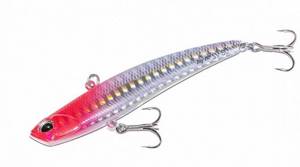
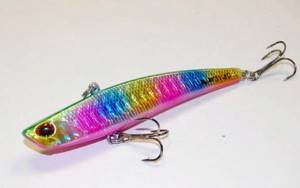
Rating (2020): 4.51
- Nomination
Best value in the category DUO Bay Ruf is the most affordable Ratlin in the premium segment. Its price is 30% cheaper than offers from its closest competitor, Bassday.
- Characteristics
- Average price: 1050 rub.
- Country: Japan
- Length, mm: 70-80
- Wobbler weight, g: 11-15
The fast-growing Japanese fishing equipment company DUO offers fans of ice fishing with classic rattlin designs. The original purpose of this catchy vibe is vertical fishing and casting. But ratlin became truly popular when used in winter. The flat-shaped tackle with low weight has proven itself to be very effective in fresh water bodies when catching pike perch and other predators. The bait works flawlessly due to its special game and spiral movement. When wiring, the tackle creates additional vibrations due to the internal design features and better attracts the attention of the inhabitants of the reservoir with the help of acoustic waves. The best way to retrieve when ice fishing is jerking with long pauses.
Top 3. Madness Shiriten Baguette
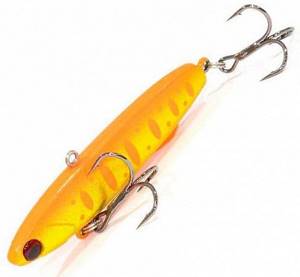

Rating (2020): 4.76
- Nomination
The choice of experienced walleye anglers, the Wib Madness Shiriten Baguette, due to the features of its design, gives a unique game, and when ice fishing in winter it guarantees its owner a successful bite.
- Characteristics
- Average price: 1470 rub.
- Country: Japan
- Length, mm: 70-80
- Wobbler weight, g: 17-28
The Japanese developers of this Ratlin, popular among fans of winter fishing, took an unconventional path. Having sacrificed a little external realism, they created a catchy vibe, the main luring factor of which was a powerful game. A unique animation is created due to the thickened front part - the rattlin’s body, which is flat on the sides, sways when retrieved, actively attracting pike perch and other river predators. Made from silicone, the Madness Shiriten Baguette vibe is shaped like a bakery product, which is reflected in its name. A weighting rod is hidden inside, making the tackle more effective when fishing from ice in winter. But even in summer it occupies a worthy place in the arsenal of experienced walleye fishermen - vertical fishing from a boat rarely leaves without a trophy.
Winter. Zander. Rattlins
- home
- Archive
- Nizhny Novgorod fisherman
- Winter. Zander. Rattlins
Igor Golishchenko
Photo by the author
NIZHNY NOVGOROD FISHER No. 6 (71) NOVEMBER-DECEMBER 2018
A passionate fisherman can talk about his baits for hours. The relevance of this topic is explained simply: there are fewer and fewer fish in our reservoirs, and there are more and more people who want to catch them; predators are now few in number and picky, and the result of the day spent on the ice will depend on how and what kind of bait is used. Today we will talk about rattlins.
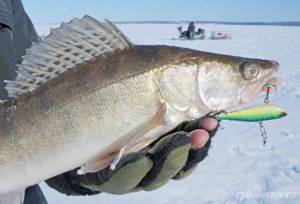
For our Volga fishermen, different models of rattlins are far from exotic; in the summer, spinning anglers have been catching our predatory fish with them for a long time and successfully, but in the winter, from the ice, they began to be widely used relatively recently, although the surge of feverish interest in this bait has already passed, many have bought, but they failed to understand. Today, the shelves of fishing stores are replete with dozens of models of VIBs: from branded Japanese products with a hefty price tag to very inexpensive Chinese copies of famous manufacturers, sometimes having only a superficial resemblance to the original. Let's try to understand all this motley diversity. I hope my ten years of experience in using these baits in winter pike perch fishing will be useful to the readers of the magazine.
Rattlin (from the English Rattle in - to rattle) is a familiar term for the ear of a Russian fisherman, but not entirely accurate, since not all baits of this type have a “rattle” inside the body. It would be more correct to call them VIBs. VIB – this is the designation that can be seen on the packaging of any of the baits of this class.
Actually, the Japanese designed these baits as a “class”.
Fishermen from birth, founders and trendsetters in sea predator fishing using sinking bladeless wobblers, the main feature of which was the ability to produce high-frequency vibrations on the retrieve (VIBration). First of all, it’s worth finding out: what VIBs can do and what they can’t do. Without understanding the game of bait, it makes no sense to catch it. Each type of bait has a number of individual game properties. Vertical spoons, for example, are able to glide on a drop or dive “with shedding”, slightly deviating from the vertical, or “nail” (jigs), producing a monotonous low-amplitude vertical game, demanded by a passive predator. Balancers are horizontal baits, their trump card is their great external resemblance to small fish and a horizontal type of movement, consisting of moving to the side and returning to the hole in a “figure eight” or “loop”. All these functions of the spinner or balancer are already set by the manufacturer by changing the shape, bending curvature, size, weight and changing the center of gravity. For the most part, these baits were conceived and created specifically for the vertical type of animation (Ice Jig). With VIBs everything is different. Initially, this bait was created specifically for casting fishing, and it is animated by separate broaches or uniform wiring with a pronounced horizontal component of movement. When using them for ice fishing, we initially have a very meager set of possible manipulations.
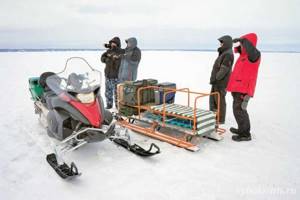
The strength of any vibe is its high degree of external similarity to the real food object. This is especially important in winter. Body proportions, realistic coloring options, “expressively executed eyes”, fins - all this makes the VIB as similar as possible to the usual food item of a predator.
The spinning bait itself searches for the predator, appearing in the zone of perception of its sense organs only for a short time. Having “heard” it from a distance with its lateral line, the predator positions itself in anticipation of visual contact. He has only a few seconds to decide whether to attack the bait or not, because after a short time the “victim” will again disappear from his field of vision. The exact external similarity of the bait to the food fish is not at all important here. In winter everything is different. Transparent cold water makes the predator’s visual analyzer the main one; it itself approaches the bait that appears in its field of vision. He also has time to examine the bait in detail, making several approaches to it. To believe that a predator does not see the difference between a live fish and an artificial bait is, to say the least, naive. The fisherman is helped here by the innate curiosity of a predator, always interested in everything unusual, especially what sinks to the bottom from the surface, and reflexes of innate aggression - the degree of edibility of a new object that suddenly appears in the field of vision can only be determined by “tasting it on the tooth.” . The ideal option is to attract several predators at once with artificial bait, which automatically turns on the reflex of food competition between them.
For a successful winter bait, mere external resemblance is not enough; it must not only look naturalistic, but also move in the water no less realistically. The clear favorite in this category is the balancer. Skillfully animated by the fisherman's hand, the balancer's movements strongly resemble a small living fish. At the same time, the fish is nimble and healthy, which is hunted by a hungry, active predator. Whether well-fed or passive, the predator will only glance at it out of curiosity or butt it without opening its mouth. A broken or sick fish will receive maximum attention; this is what the VIB depicts in vertical animation, quite realistically.
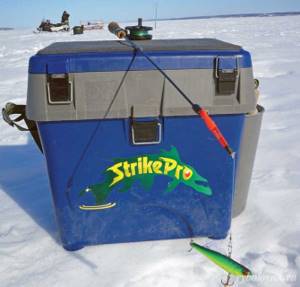
Wobblers of the VIB class (rattlins), being horizontally oriented volumetric baits, in winter are forced to work in a rather limited vertical column of space and in this way are somewhat similar to vertical spinners. Rattlins do not have that sweeping amplitude of departure from the vertical when pulling, like balancers; they move away from the axis only on release, and then the same “balance turn” follows and returns to the hole, only much smoother, more natural and leisurely than it happens with balancers
The main feature of any VIB is the ability to create vibration during intense stretching, “crackling”. This function is inherent, apart from them, only in bladebaits (“cicadas” and their numerous variations) and is extremely in demand in the summer.
Vibrations of different frequencies are characteristic of a wounded, beaten fish, which for some reason has lost the ability to move properly. For any predator, this is an invitation to dinner and easy prey. In summer, when visibility under water is limited and, at best, a meter or one and a half, the vibration of the rattlin is “audible” to the predator from tens of meters. In winter, when fishing from ice, with water as clear as a tear and cold, these vibrations are not so relevant, but they also attract a predator from a great distance. You may not be able to wait for a bite from a single fish with such an “explosive” game, but it works in a different way - attracting not one, but several predators under the hole at once, and increases their degree of aggression by turning on the mechanism of food competition with each other.
If we specifically examine and compare the play of balancers of different body shapes, weights and sizes, from different manufacturers, we will see a very similar play in design, differing only in small nuances. But it is precisely these nuances that are extremely important for a predator; this forces us to purchase and take with us on the ice a considerable assortment of various balancers. VIBs (rattlins), with a seemingly much more meager set of vertical animation movements, differ from each other in the game even more significantly, performing the same element or movement in completely different ways. A slight change in the external shape or proportions of the body, the displacement of the load, the size of the air chamber and its location gives a large number of movement options, making one or another VIB highly specialized and unique, like a specialized surgeon’s instrument, designed to perform a very specific task during an operation.

The high variability of movements of various VIBs requires the fisherman to systematize these baits and the ability to use and animate them not just “as it pleases,” but with a clear understanding of what kind of game will be in demand by the local predator, and which VIB out of the box will do it better than others. This is the most delicate moment. Having selected the correct VIB for the location, we have in our hands a bait that is superior in catchability to most balancers and vertical spinners. But what about in practice? Easier said than done. Everyone’s bait animation techniques are very individual, and we always try to adapt any new bait to the type of movements that are familiar to us and have become automatic, but which are not always best suited for a specific VIB model.
In reality, this is what happens most often.
A person buys one or several VIBs “to try,” it’s good if he spares no expense and buys original branded VIBs; in any case, they can then be sold, earning most of the money spent on them, or used effectively in spinning fishing in the summer. It’s worse if you purchased Chinese copies of famous brands. Now, with the growing popularity of winter fishing with VIBs, there are more and more of them on sale. Some of them are quite functional, but most of them are rather rubbish: in the summer they can still be fed to the fish, but in the winter everything is sad, they are guaranteed the role of extras. Chinese manufacturers copy everything that is in demand. It is possible to accurately reproduce the appearance and weight of a branded VIB, but accurately copying its internal structure is quite difficult and expensive.
By the way, at one time I had an original branded “Saurus” in my arsenal, and it quite successfully caught pike perch for me; on one of the fishing trips it “died”, getting tangled in a piece of a net that had washed up at the bottom.
To replace it, I bought a couple of Chinese copies, outwardly difficult to distinguish from the original - however, in a season and a half I did not see a single bite on them! Here, most likely, there is my weak faith in the bait-copy and, of course, also some nuances of the clone’s behavior. Now let's talk about VIB options. And the specializations of each option.
1. All-metal VIBs.
Compact and fairly heavy baits. Designed to work at great depths with a noticeable current or simply in a strong current. In its purest form, channel baits. The ability to vibrate is due to the shape of the body, in cross section close to a narrow isosceles triangle with the base at the bottom. They are very close to classic metal bladebaits, but have much greater external naturalism. As a rule, the set of movements performed by this type of VIBs is very meager, but quite sufficient for the conditions for which they are intended.
The main thing is that they allow you to maintain clear contact with the bait in the current and depth, and the flow of water running onto the bait helps the fisherman, causing the bait to move in place and yaw a little even when the angler’s hand is motionless.
2. VIBs with a heavy metal load and a plastic body.
Plastic can be completely different: from translucent polycarbonate or acrylic resin to dense silicone, which has recently become popular (the Japanese company Madness became the trendsetter and founder of this type of VIBs; now it is copied with great success by many small Chinese manufacturers). The combination of materials of different densities and weights makes the bait quite voluminous, and the different placement of the metal weight inside allows you to change the position of the center of gravity. VIBs of this type have excellent ballistic qualities and tough high-frequency play - in a spinning rod they are uncompromising and irreplaceable fighters in deep jigging reservoirs. In winter, using only the vertical type of animation, they behave much more modestly.

3. VIBs with an air chamber.
Lures that have one or more air chambers in the tail section. The air chamber in the tail helps the VIB to take a certain, strictly specified angle of inclination under water (usually from 25 to 45 degrees). For casting fishing, this is a huge plus: the bait flies with the weighted head end forward, there is practically no overlap of hooks. In the water, due to the air chamber, such a bait immediately takes the correct position, protecting the hooks from bottom debris (and, to some extent, hooks). And what can these VIBs do when fishing from ice, with vertical animation? First of all, the presence of an air chamber allows you to make the bait quite voluminous and having (depending on the size of the chamber and the shift of the CG) a large number of options for playing at a qualitatively different level - not angry and noisy, but smooth and low-amplitude - characteristic of the behavior of fish in cold and oxygen-poor conditions winter water. In addition, the air chamber is an excellent acoustic resonator, amplifying noise from the mutual movement of tees and metal fittings of the bait.
The other side of the coin is that VIBs with an air chamber have significantly different weights in air and in water.
The volume of air in the chamber underwater significantly reduces the rattlin's negative buoyancy. For example, a wide-bodied model that weighs 18 grams in the air has a negative buoyancy of 3-4 grams (weight under water), so it is unlikely that it will be possible to drive such a bait to a decent depth in winter and effectively control it.
4. VIBs that have an air chamber and noise elements in their design.
There may be several of these elements, or it may be just one large metal ball. Often, a manufacturer produces both types of the same bait at once. Its labeling always contains a corresponding indication. For example, in “Pantun 21” lures the VIBs are marked SL Silent__ (quiet) or NS – Nano Sound (quiet sound). For other manufacturers, the presence of a noise capsule is indicated by the letter R or the inscription Rattle-in. In fact, the manufacturer, to some extent, is trying to divide the baits into purely summer and winter ones, with a predominantly vertical type of animation. This is more of a marketing ploy, because an angler who successfully fishes with a noisy rattline in liquid water will definitely purchase its other, “quiet” version for fishing in cold water or from ice.
The advantages of silent VIBs over “pure” Rattlins in ice fishing are a matter of much debate, although both are catchable. When catching a passive predator, “noisy” baits often have a negative effect, but in most cases, in clear winter water, pike perch don’t care whether the bait “rattles” or not. Even a “quiet” VIB without a chamber with noise elements has winding rings, tees and clasps that create a lot of noise when the bait moves.
Some anglers see practical value in dividing VIBs into groups based on their body proportions. With a tall body - “crucian carp”, of medium proportions - “roach” (aka shad) and runaway, narrow-bodied - “bleak sprat”.

“Crucian carp” - classic high-bodied rattlins, as a rule, have an air chamber of considerable size containing noise elements. For their volume they have low negative buoyancy. They are designed for fishing at very modest depths of up to six meters - and therefore these are, rather, pike baits, although in appropriate conditions they can also catch pike perch. They have a sweeping, amplitude game even on weak stretches; on release they deviate slightly from the vertical.
“Roach” are classic shad, less wide-bodied baits with a slanted profile. Air ca-So what can this or that particular VIB do in water? To answer this question, it is best to start fishing at home. Whether it is a standard bathtub filled with water or a deep bathtub is not important. A test animation in a decent container of water allows you to understand the main thing: what can be done with this particular VIB, and what should not be done. On the ice, this knowledge is priceless. Home tests will show with great certainty at what angle the VIB hangs under water and how it will respond to certain animation techniques. You need to remember this and also try to find a “trick” - that specific animation technique that will force the VIB to make a purely individual, specific movement in the water that is unique to it. Even on the all-knowing Internet, it is quite difficult to find any specific information about the animation of VIBs. On forums discussing fishing with VIBs, they describe everything except specific animation techniques. Actually, there are not so many of them.
Quick lifting of the VIB (broaching). Being a distant relative of the bladebait, the VIB produces a vibration that is noticeable by the hand, but much softer than that of the classic metal “Cicada”. In the summer, when spinning, this is the main type of animation. But in winter we don’t need such noise. The only purpose of fishing in winter is to attract pike perch from afar. 3-4 pulls on a fresh hole will always be relevant. You just need to do this thoughtfully, choosing a pulling speed that will allow the rattlin to vibrate as gently as possible, to the point of breaking for a specific type of bait. The only thing that needs to be taken into account is that at depths of ten meters or more, a good half of the catchable VIBs will not be able to transfer the pleasant “T-r-r-r-r-r” into our hands, even on a cord. This does not mean that the bait does not work. It’s just that at this drawing speed the vibration will be low-frequency, the hand will not feel it, but there is no doubt that the VIB will make a great noise under water.
Drawing is one of the most aggressive elements of VIB’s winter animation; everything else is much more modest. Slow ascents, drops, “ladders” up and down, drops with a hold, jig – this is, perhaps, the entire arsenal of techniques. At the same time, each of the different VIBs will dance underwater in an original way, in their own way. At the drop, some are able to go far to the side and then slowly return, making a wide loop; others actively work the back part of the body during care; still others only yaw briefly, moving away from the vertical by only a dozen or two centimeters. That is why home tests of the VIB are needed, which will show what the new bait is capable of in action. The generally accepted, “folk” animation of VIBs is very simple. Usually this is a jig, a smooth rise with a pause at the top and a descent down 2-3 steps. Or vice versa: a leisurely “ladder” up and a smooth descent. For “advanced” players, this game is broken up by a series of high rises and releases, sometimes with a slight hold, or swinging the bait in one place with an amplitude of 5-10 centimeters (usually, the VIB begins to cut circles under the hole). By varying the length, the measure is small or absent altogether. They have decent negative buoyancy, hold the Volga current well and are well controlled at great depths. The majority of VIBs that catch pike perch belong to this class.
They “start up” easily on vertical pulls, and on release they go a considerable distance from the vertical, slowly returning in a loop to the starting point.
“Bleak-tulka” are elongated VIBs, almost round in cross-section, some have a high plastic fin for stabilization. As a rule, they have high-frequency play with a small amplitude of oscillations and pronounced negative buoyancy. These VIBs are more stable in the current and are excellent at turning on a passive predator, although outwardly their game looks quite stingy.
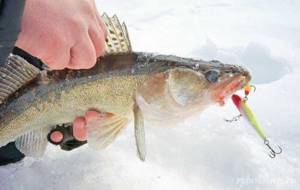
Separately, it is worth highlighting a group of rattlins with a rounded (cigar-shaped) shape, which are not at all able to vibrate while pulling or cast fish; in fact, they are not even VIBs, however, these voluminous lures were specially created for winter vertical animation (Ice Jig). Prominent representatives of this family are the good old Salmo Chubby Darter or La Bamba from Strike Pro. Lures with a forward CG and decent drag have an extremely mobile rear part, which is actively involved in the work during any vertical movement. They have their own bright individual and very attractive game. If “Chabik” is a bait for relatively shallow water areas and catches pike perfectly, then “La Bamba” is quite a pike perch device.
So what can a particular VIB do in water? To answer this question, it is best to start fishing at home. Whether it is a standard bathtub filled with water or a deep bathtub is not important. A test animation in a decent container of water allows you to understand the main thing: what can be done with this particular VIB, and what should not be done. On the ice, this knowledge is priceless. Home tests will show with great certainty at what angle the VIB hangs under water and how it will respond to certain animation techniques. You need to remember this and also try to find a “trick” - that specific animation technique that will force the VIB to make a purely individual, specific movement in the water that is unique to it. Even on the all-knowing Internet, it is quite difficult to find any specific information about the animation of VIBs. On forums discussing fishing with VIBs, they describe everything except specific animation techniques. Actually, there are not so many of them.
Quick lifting of the VIB (broaching). Being a distant relative of the bladebait, the VIB produces a vibration that is noticeable by the hand, but much softer than that of the classic metal “Cicada”. In the summer, when spinning, this is the main type of animation. But in winter we don’t need such noise. The only purpose of fishing in winter is to attract pike perch from afar. 3-4 pulls on a fresh hole will always be relevant. You just need to do this thoughtfully, choosing a pulling speed that will allow the rattlin to vibrate as gently as possible, to the point of breaking for a specific type of bait. The only thing that needs to be taken into account is that at depths of ten meters or more, a good half of the catchable VIBs will not be able to transfer the pleasant “T-r-r-r-r-r” into our hands, even on a cord. This does not mean that the bait does not work. It’s just that at this drawing speed the vibration will be low-frequency, the hand will not feel it, but there is no doubt that the VIB will make a great noise under water.
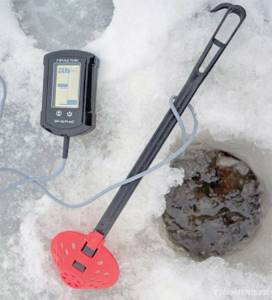
Drawing is one of the most aggressive elements of VIB’s winter animation; everything else is much more modest. Slow ascents, drops, “ladders” up and down, drops with a hold, jig – this is, perhaps, the entire arsenal of techniques. At the same time, each of the different VIBs will dance underwater in an original way, in their own way. At the drop, some are able to go far to the side and then slowly return, making a wide loop; others actively work the back part of the body during care; still others only yaw briefly, moving away from the vertical by only a dozen or two centimeters. That is why home tests of the VIB are needed, which will show what the new bait is capable of in action.
The generally accepted, “folk” animation of VIBs is very simple. Usually this is a jig, a smooth rise with a pause at the top and a descent down 2-3 steps. Or vice versa: a leisurely “ladder” up and a smooth descent. For “advanced” players, this game is broken up by a series of high rises and releases, sometimes with a slight hold, or swinging the bait in one place with an amplitude of 5-10 centimeters (usually, the VIB begins to cut circles under the hole). By varying the length of pauses between elements and the tempo, the angler selects the most advantageous type of game for the location. The bites are always only on pause. Active animation is in demand in the summer, then intensive pulls with a spinning rod and a series of jerks both collect and turn on a predator of any stage of activity.
When fishing vertically in winter, we not only do not have enough distance for amplitude techniques, but we also experience overlaps when using jerky types of animation, and in addition, in winter, in the overwhelming majority of cases, pike perch attacks the bait on a pause. A fisherman who does not have an echo sounder works blindly and does not know at what moment a predator attracted by active play approaches his VIB, and at what period of time the VIB needs to “shut up”. An active and noisy element of the game under the very nose of a predator will scare it away in any case, and the attack (bite) simply will not take place. Therefore, we are forced to use only smooth descents and ascents of the bait and jigs in the game.
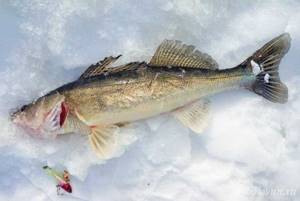
Using an echo sounder, the fisherman has a fairly stable “feedback channel” with the predator on the ice.
With an echo sounder, it is possible to track the fish’s reaction to manipulations with the bait, to understand “here and now” what attracts and excites the pike perch under the hole, and what type of animation it does not like at the moment. Without an echo sounder, the fisherman does not even suspect how many predators come under the hole to look at the bait: an underexposed pause, a sudden movement - and the fish gradually falls away, having lost interest in what is happening. With an echo sounder, the animation of the winter bait becomes meaningful. Some people use serious expensive devices for this purpose, specially designed for ice fishing (flashers), while others use a simple winter “Practice”. The flasher didn’t take root in my fishing.
Its dimensions and weight seriously limited the mobility of fishing, but the small domestic “Praktik”
, which fits freely in the bosom of overalls or in a jacket pocket, suits absolutely everyone. The “Pro” mode is used exclusively, providing pure, uninterpreted information about what is happening under the hole.
As an apologist for vertical spinners, catching pike perch with a VIB always seemed a little boring to me, precisely because of the monotonous, inexpressive animation. The hand itself asked for the usual short tosses, cuts, mental counting of the spinner's plays during the pause, read by the nod. Some people mistakenly believe that fast spinning spoons are used to catch an active predator, but give a jig to a well-fed and sluggish one. This is not so - a spinner with a pronounced action on the fall can significantly increase the level of activity of a sluggish pike perch and provoke it to attack. If a vertical spoon or “Cicada” can do it, then why can’t a VIB do it? A short toss - a typical element of the animation of a vertical spinner - is absolutely contraindicated for the VIB; most often this leads to the rear tee overlapping the fishing line or cord. VIBs that have an air chamber and initially occupy a position under water with a pronounced downward tilt of the head are especially guilty of this.
The first and main rule of fishing with VIBs is to never fish with them at the very bottom. The presence of a pocket echo sounder always allows us to know the depth under the hole, but the presence of the fish we need under the hole is not at all necessary. A scattered and passive predator can be pressed to the bottom and not be displayed by a simple echo sounder or not fall into the cone of its beam. But even in this phase of activity, pike perch and bersh are extremely curious and constantly watch for what might “fall from the sky” - a sinking bait that plays seductively as it falls will never go unnoticed. Lowering the VIB immediately into the bottom layer means killing the intrigue; a passive predator will quickly lose interest in it, and active movements of the bait at the bottom will immediately scare it away.
Usually we stop the free fall of a VIB one and a half to two meters from the bottom, after which we take a long pause: a high-hanging VIB is visible to a predator from a considerable distance, and it may take time for the fish to approach the bait and find itself in the echo sounder beam. The next cycle of the game - several “evil” animation techniques - a couple of pulls with vibration, “hitting the bait” and dropping it “with a hold”... and again a long pause. If this does not bring success, we drop the bait lower - and after a pause we repeat the game cycle. In any case, the minimum height of the VIB above the bottom is half a meter. Our task is to find out whether there is a predator at all in the place of fishing, and to determine the degree of its feeding activity. By observing our bait in “Practice”, we can understand all this.
Usually an active predator interested in VIB starts from the bottom towards the bait. By the thickness of the line of a correctly configured echo sounder, you can determine the approximate size of the predator, and by the speed of its rise, you can judge its activity. A completely phlegmatic predator reveals its presence by the heterogeneity of the bottom strip, or the bottom “begins to bulge” - the predator does not want to come close to the object of interest to it. Changing the horizon and repeating the game cycle can activate it and force it to rise to the VIB.
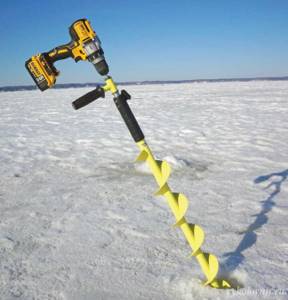
The rise of a predator to the bait is fundamentally different. A quick, decisive rise, as a rule, ends in an attack; slow and leisurely ones do not end in anything. In any case, we already know about the presence of a predator under the hole; all that remains is to catch it. Changing the bait can help here; almost always a specific model (color) of VIB is followed by an attack, although today pike perch may only come up to look at other, quite working models. Any cycle of active play of the bait while the predator is rising to it cancels the attack.
The pike perch just leaves. It will not be possible to provoke an attack by helpfully lowering the bait to the level or slightly below the pike perch moving away from it. This doesn’t work, but getting the fish to repeat the approach and come back is quite possible. The vib should make several movements of minimal amplitude, the impact of which on the side line will force the pike perch to turn around and become interested in the bait again. Usually this is a couple of seconds of jig motion with a minimum amplitude or a “blow” into the bait - a sharp drop of the bait down a couple of centimeters and immediately a sharp and very short jerk upward by the same 2-3 cm. At this time, the VIB makes one short movement - it lies down on its side and then returns to its original position, a cycle of short damped oscillations is generated, very reminiscent of the behavior of an agonizing victim: it is difficult for a beaten fish to maintain balance, and it periodically lies on its side. Such a short movement, as a rule, forces the pike perch leaving the bait to return to it again.
The only win-win option to persuade a passive predator to bite is to move the VIB upward from the pike perch. This is guaranteed to increase the degree of aggression. At its core, pike perch is a bottom-dwelling fish, and is reluctant to leave the lower horizon of the water column, but the higher the predator rises up behind the bait that slowly moves away from it, the greater the likelihood that everything will end in an angry, hard bite. We move the VIB away from the pike perch rising towards it as slowly as possible, with pauses.
It turns out to be a kind of game of “cat and mouse”, recorded by an echo sounder. It is interesting in itself, but you shouldn’t get carried away with it for a long time, 3-4 “empty” lifts to the bait - there is already a reason to change the model of the bait, put on a VIB that has a different game, size or color.
Everything I described above works effectively in conditions that allow you to see your bait in the echo sounder screen, but in some cases this is impossible. At a considerable depth of the riverbed, even a weak current carries the bait out of the echo sounder beam.
Most anglers, in order to maintain visual contact, follow the path of increasing the weight of the VIB, but this is not always justified. A larger or heavier VIB model has a completely different game pattern. In this situation, it would be correct to fish “blindly” with a VIB, excluding all active elements from the animation techniques and lengthening the pauses; usually a regular small-amplitude jig is sufficient. The force of the current “revitalizes” the voluminous bait. High lifts are not required either. During the current, the predator is forced to press against the microrelief of the bottom and is extremely reluctant to move up more than a meter. Here, the upper horizon for fishing with VIBom narrows significantly - to 70-80 cm from the bottom; heavy and compact models of small sizes are most in demand. Large models (75-80 mm) “rule” in “distributions” of schooling and active pike perch.
And finally, a few more practical tips:
You need to believe in the bait, try for a couple of fishing trips and not take any other baits with you on the ice except VIBs, maybe you will catch less than others, but you will have confidence in the bait.
Don’t buy many different VIB models at once, stop at 2-3 of the most popular branded models in different colors and weights, all season long you will discover all their new capabilities and practice your animation skills. When personal experience appears, all subsequent purchases will be meaningful, and the purchased VIBs will only work, and you will save a lot of money.
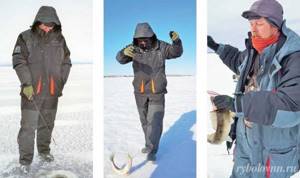
Any VIB does not require hooks to cut sprat and other edible attributes; it is not a spoon. The bait kills the game of the bait; it may catch, but it will be much worse. The presence of decorations - colored cambrics on the undersides, or a tee with a beautiful colored “drop” on the “belly” of the VIB is quite acceptable, but does not in any way affect the bite in the direction of its improvement, but it significantly increases the angler’s faith in the catchability of the bait tuned in this way.
Top 2. Bassday Range Vib
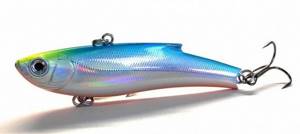

Rating (2020): 4.81
- Nomination
The most reliable choice for trophy fishing The presence of the largest bait size in the series (100 mm) and the catchability tested by many professional pike perch fishermen make it mandatory to use this vibe in the arsenal of an experienced angler for trophy pike perch.
- Characteristics
- Average price: 1288 rub.
- Country: Japan
- Length, mm: 55-100
- Wobbler weight, g: 10-33
This catchy Range Vib from the popular Japanese brand Bassday is appreciated by many ice fishing enthusiasts. The Ratlin is designed for hunting large predators such as pike perch or pike, and has shown excellent performance in deep water. This is facilitated by the shape of the rattlin, brought to perfection. Tackle for winter fishing has been produced for many years; the shape and color options have now been perfected to the best standard. In addition, the legendary sinking wobbler is a universal tackle. They catch fish with it both in winter and summer. For fishing from the shore, it has excellent aerodynamics and excellent balancing, ensuring the accuracy of long casts. The tackle is equipped with two sharp tees in the front and tail parts of the “fish”, and the winding ring is located on top.
See also:
- 20 best wobblers
Selecting the type of ratlins
Before deciding on the type of bait, you should look at what parameters it will be produced according to.
Ratlins differ in the following characteristics:
- Form;
- Weight;
- Size;
- Colors;
- Sound;
- Manufacturer.

The shape of any ratlin is one of the main criteria of attractiveness for a particular predator. At the same time, it would be a mistake to believe that the same pike perch will appreciate the smooth curves of the body of some baits and reject the shape of others. The point is how a ratlin of one form or another will behave in the water.
Having studied the opinions of many experienced fishermen, one can come to a more or less consistent opinion that pike perch are more interested in the game of sharp-faced types of ratlins, such as Sebile or Tsuribito. But, since the potential of the newfangled volumetric cicadas has not yet been fully revealed, other effective solutions cannot be ruled out.
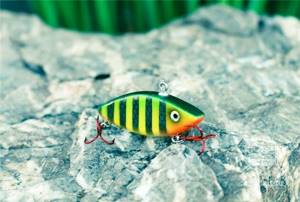
The weight of ratlins is directly related to the depth and speed of their immersion. They are usually used at a depth of 4 to 6 meters. For fishing at greater depths, it is worth taking a closer look at the heavier options from Japanese manufacturers, designed for deep sea fishing.
As experience shows, the smaller the size of the bulk bait, the more often the bite occurs. On the other hand, large specimens should also be used to catch large fish. For pike perch, the best option would be an average length of 5 to 7 cm.
The color of ratlins is much less important than their weight or shape. There are natural and “acid” colors. Natural shades are used in clean and transparent bodies of water, and bright unnatural or “acidic” ones are used in muddy water. Pike perch, among other shades, prefers silver, white or transparent colors.
Since any bait interests pike perch with movement and sound, the presence of a rattle is an essential factor. As a rule, “rattle” ratlins are used in the summer, but silent ones are used in winter.

The number of ratlin manufacturers today exceeds the limit of visibility. Without pursuing commercial goals within the framework of this article, we will not recommend this or that manufacturer. When choosing bait, it will be enough to focus on the basic properties and cost of the product.
